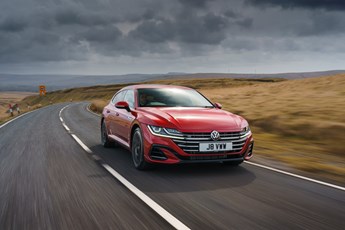
The start point for the best source of fleet information |
Model update: Volkswagen Arteon Shooting Brake eHybrid
Date: 24 June 2021 | Author: Sean Keywood

|
|
||||||||
When carmakers launch a new model, sometimes they make a big impression straightaway and on other occasions they take longer to find their feet. The latter category could be proving the case with Volkswagen's Arteon. It first arrived in 2017 as a sleeker, fastback counterpart to the Passat upper-medium car. A facelift in 2020 then brought improved interior design and technology, and also extended the range's appeal with the addition of an estate, badged Shooting Brake. And now, in an update that will perhaps make the Arteon more interesting to fleets than ever before, a plug-in hybrid variant has also been introduced.
Badged eHybrid, it's a powertrain we're becoming increasingly familiar with in VW Group cars, pairing a 1.4-litre petrol engine with an electric motor for a combined output in this case of 218hp. The car sets off by default in pure EV mode, and is easily capable of completing a decent commute without troubling the petrol engine at all, even if motorways are involved (the EV range is 39 miles under WLTP testing). If the engine is needed, such as under heavy acceleration or when the battery is running low, the transition between EV and engine running is so seamlessly managed and the engine so refined that around town you wouldn't know it was happening without an eye on the rev counter. The powertrain is paired with a six-speed DSG gearbox, and it's a good partnership, with the instant power of the electric motor helping avoid the hesitancy at junctions we've occasionally experienced before with these transmissions.
With the R-Line equipment grade tested here, official fuel economy and CO2 emissions figures are 201.8mpg and 32g/km respectively. While excellent in isolation - though of course fuel economy will be hugely dependent on regular battery charging - it's worth noting that with the alternative - and slightly cheaper - Elegance equipment grade these figures improve to 256.8mpg and 27g/km.
The main selling point with the R-Line is a sporty makeover including body kit, 19in alloy wheels and dual trapezoidal exhaust tips. However, despite appearances, even in this spec the Arteon is far happier being driven in a relaxed manner than attacking a series of B-road bends - there's nothing untoward about the handling, but you always feel the weight of the hybrid batteries in corners and it doesn't feel very agile. But then this clearly isn't meant to be a sports car and as a comfortable cruiser the Arteon shines. The suspension set-up is impressive, delivering a ride that's not overly soft but highly polished, while refinement and the level of comfort from the seats are also highlights. A particular boon for longer journeys is the adaptive, predictive cruise control system, which responds not just to the speed of other cars, but also to bends in the road and to speed limit changes. It means you can cover mile after mile without needing to do anything other than turn the steering wheel - though a glitch on our test meant the system occasionally seemed to think it was in mainland Europe, displaying the speed limit in kph and being reluctant to overtake on the right, seemingly thinking that would be undertaking.
The Arteon's interior is another plus point, with a high standard of materials used and a well-resolved infotainment set-up with a separate panel for climate controls, and a physical audio volume knob thankfully retained. Despite the Arteon's fastback roots rear headroom is fine and there's lots of legroom. As is often the case with PHEVs, boot space is compromised by the need to accommodate the battery, however, the Shooting Brake body style means a highly useful 455 litres of space is still available with the rear seats in place, down from 563 litres with ICE cars.
Despite the Arteon's billing as a more stylish model, it's actually closely matched on price with the equivalent Passat and also fellow VW Group model the Skoda Superb, and with the Arteon boasting stronger predicted residual values, it should work out slightly cheaper than those models over a three-year use cycle. The Arteon also has an RV advantage compared with the Peugeot 508 SW, another fastback-based estate PHEV.
Volkswagen Arteon Shooting Brake R-Line eHybrid
P11D: £42,115
Residual value: 35.6%
Depreciation: £27,138
Fuel: £1,693
Service, maintenance and repair: £2,724
Cost per mile: 52.59p
Fuel consumption: 201.8mpg
CO2 (BIK %): 32g/km (11%)
BIK 20/40% a month: £77/£154
Luggage capacity: 455 litres
Engine size/power: 1,395cc/156hp plus 115hp electric motor
Verdict |
8/10 |
|||
 |
|
 |
|
|










